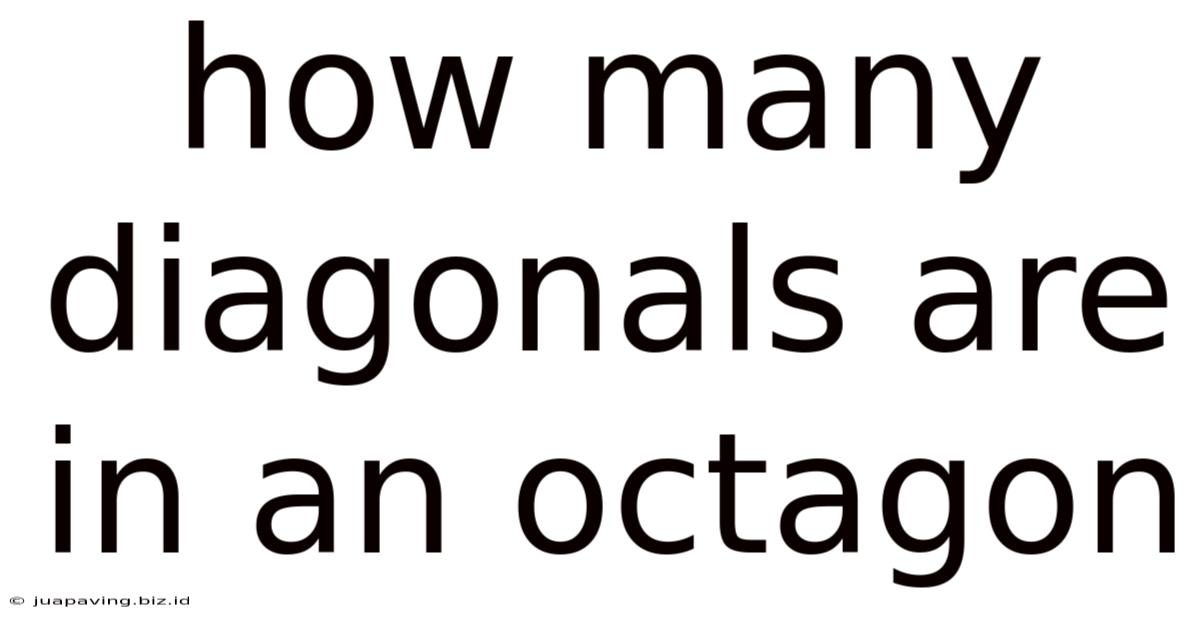How Many Diagonals Are In An Octagon
Juapaving
May 13, 2025 · 4 min read

Table of Contents
How Many Diagonals Are in an Octagon? A Comprehensive Guide
Determining the number of diagonals in an octagon might seem like a simple geometry problem, but understanding the underlying principles reveals a fascinating connection between geometry and combinatorics. This comprehensive guide will not only answer the question but also explore the mathematical concepts behind it, providing you with the tools to solve similar problems for polygons of any size.
Understanding Diagonals
Before diving into the octagon, let's define what a diagonal is. In any polygon (a closed figure with straight sides), a diagonal is a line segment connecting two non-adjacent vertices (corners). It's crucial to understand that a side of the polygon is not considered a diagonal.
The Octagon: A Closer Look
An octagon is an eight-sided polygon. Imagine an octagon drawn on a piece of paper. To understand the number of diagonals, we need a systematic approach to avoid double-counting or missing any.
Method 1: Visual Counting (For Small Polygons)
For smaller polygons like the octagon, a visual approach can be effective. Start at one vertex and count the number of diagonals that can be drawn from that vertex to other vertices. Avoid counting sides as diagonals.
- Choose a vertex: Select any corner of the octagon.
- Count diagonals: From this chosen vertex, you can draw diagonals to five other vertices (excluding itself and the two adjacent vertices).
- Repeat for all vertices: Repeat steps 1 and 2 for every vertex in the octagon. However, doing this directly counts each diagonal twice (once from each endpoint).
This visual method is practical for octagons but becomes cumbersome for polygons with many sides. It is more susceptible to errors as the number of sides increases.
Method 2: The Combinatorial Approach (For Larger Polygons)
A more robust and scalable method involves the principles of combinatorics. This approach works for any polygon with n sides.
-
Total number of line segments: First, consider all possible line segments that can be drawn between any two vertices of the octagon. This is a combination problem – choosing 2 vertices out of 8. Using the combination formula:
nCr = n! / (r! * (n-r)!)Where:
nis the total number of vertices (8 in this case)ris the number of vertices we choose for a line segment (2 in this case)
This gives us:
8C2 = 8! / (2! * 6!) = (8 * 7) / (2 * 1) = 28 -
Subtracting the sides: The result of 28 includes the eight sides of the octagon. Since sides aren't diagonals, we must subtract them:
28 - 8 = 20
Therefore, there are 20 diagonals in an octagon.
The General Formula
The combinatorial method allows us to derive a general formula for the number of diagonals in a polygon with n sides:
Number of diagonals = n(n - 3) / 2
Where n is the number of sides of the polygon.
Let's verify this formula for the octagon (n = 8):
8(8 - 3) / 2 = 8 * 5 / 2 = 20
The formula confirms our earlier calculation.
Applications and Extensions
Understanding how to calculate diagonals is important in various fields:
- Computer graphics: Algorithms for drawing and manipulating polygons frequently rely on these calculations.
- Engineering: Structural analysis and design often involve polygon analysis.
- Mathematics: This concept is fundamental in graph theory and combinatorics.
- Game development: Many games utilize polygons for their game world. Determining diagonals might be important in pathfinding or collision detection algorithms.
Solving Similar Problems
Using the general formula, we can easily calculate the number of diagonals in other polygons:
- Pentagon (n=5): 5(5-3)/2 = 5 diagonals
- Hexagon (n=6): 6(6-3)/2 = 9 diagonals
- Heptagon (n=7): 7(7-3)/2 = 14 diagonals
- Nonagon (n=9): 9(9-3)/2 = 27 diagonals
- Decagon (n=10): 10(10-3)/2 = 35 diagonals
Beyond Regular Polygons
The formulas and methods discussed apply equally to regular polygons (polygons with all sides and angles equal) and irregular polygons (polygons where sides and angles are not necessarily equal). The key is that the polygon is simple (i.e., it doesn't intersect itself).
Exploring Further
This exploration of diagonals in an octagon provides a foundation for understanding more complex geometrical concepts. Further study could delve into:
- Properties of diagonals: Investigate the relationships between diagonals and the interior angles of a polygon.
- Diagonals and area: Explore how diagonals can be used to calculate the area of a polygon, particularly irregular ones.
- Polygons in higher dimensions: Expand the concept of diagonals to three-dimensional and higher-dimensional polytopes.
This comprehensive guide not only provides the answer to "How many diagonals are in an octagon?" but also empowers you with the mathematical tools to solve similar problems for any polygon. By understanding the underlying principles of combinatorics and the general formula, you can confidently tackle a variety of geometric challenges. Remember, the beauty of mathematics lies in its ability to provide elegant solutions to seemingly complex problems.
Latest Posts
Latest Posts
-
How Many Pounds Is 63 Kg
May 14, 2025
-
What Is A Total Internal Reflection
May 14, 2025
-
Three Ways To Charge An Object
May 14, 2025
-
300 Sq Meters To Square Feet
May 14, 2025
-
Five Letter Words Starting With S P
May 14, 2025
Related Post
Thank you for visiting our website which covers about How Many Diagonals Are In An Octagon . We hope the information provided has been useful to you. Feel free to contact us if you have any questions or need further assistance. See you next time and don't miss to bookmark.